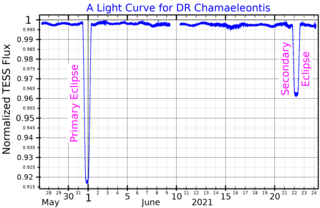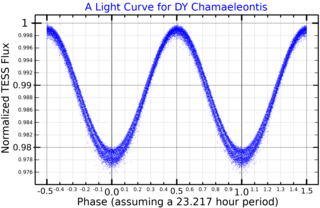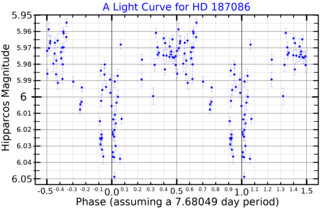
Z Chamaeleontis is a dwarf nova variable star system approximately 377 light-years away from the Sun, where two stars orbit each other every 1.78 hours. The system comprises an eclipsing white dwarf and red dwarf and possibly a yet unconfirmed third low-mass substellar companion.

Zeta Chamaeleontis, Latinized from ζ Chamaeleontis, is a star located in the constellation Chamaeleon. Located around 570 light-years distant, it shines with a luminosity approximately 522 times that of the Sun and has a surface temperature of 15,655 K. South African Astronomer A.W.J. Cousins noted it to vary between magnitudes 5.06 and 5.17 in 1960. It was classified as a Beta Cephei variable in the Hipparcos and Tycho Catalogues, with a period of 1.07 days, before being reclassified as a slowly pulsating B star in the 2011 version. It is also an eclipsing binary star, with a period of 2.7 days.

Eta Chamaeleontis, Latinized from η Chamaeleontis, is a star in the constellation Chamaeleon. It has an apparent magnitude of about 5.5, meaning that it is just barely visible to the naked eye. Based upon parallax measurements, this star is located some 325 light-years light years away from the Sun.
HD 39901 is an orange hued star located in the constellation Columba. It is also called HR 2069, which is the star's Bright Star Catalog designation. Eggen (1989) lists it as a member of the old disk population.

HD 57197, also known as M Puppis or HR 2789, is a suspected astrometric binary located in the southern constellation Puppis, the poop deck. It has an apparent magnitude of 5.84, making it faintly visible to the naked eye under ideal conditions. Based on parallax measurements from the Gaia satellite, the system is estimated to be 629 light years away from the Solar System. The value is poorly constrained, but it appears to be receding with a heliocentric radial velocity of 13 km/s. At its current distance, HD 57197's brightness is diminished by 0.3 magnitudes due to interstellar dust. It has an absolute magnitude of -0.43.
HD 47475 is a solitary star located in the southern constellation Columba. With an apparent magnitude of 6.34, its barely visible to the naked eye under ideal conditions. The star is located 1,720 light years away from the Solar System, but is drifting away with a heliocentric radial velocity of 15.77 km/s.

HD 174387 is a solitary star in the southern constellation Telescopium. With an apparent magnitude of 5.49, it is faintly visible to the naked eye if viewed under dark skies. Parallax measurements put the object at a distance of 810 light years and it is currently approaching the Solar System with a heliocentric radial velocity of −28.1 km/s.

TZ Mensae is a binary star in the southern circumpolar constellation Mensa. The system has a combined maximum apparent magnitude of 6.19, placing it near the limit for naked eye visibility. Parallax measurements place the system at a distance of 403 light years. The radial velocity is small.

WZ Columbae, also known as HD 38170, is a solitary, bluish-white hued star located in the southern constellation Columba, the dove. It has an apparent magnitude of 5.28, allowing it to be faintly visible to the naked eye. Based on parallax measurements from the Gaia spacecraft, the object is about 365 light years distant. It appears to be receding from the Solar System, having a heliocentric radial velocity of 36.3 km/s.

DR Chamaeleontis, also known as HD 93237, is a star located in the southern circumpolar constellation Chamaeleon. The system has an average apparent magnitude of 5.97, allowing it to be faintly visible to the naked eye. DR Cha is located relatively far at a distance of 1,060 light years based on Gaia DR3 parallax measurements, but is receding with a poorly constrained heliocentric radial velocity of 18 km/s.

PW Telescopii, also known as HD 183806 or simply PW Tel, is a solitary variable star located in the southern constellation Telescopium. It has an average apparent magnitude of 5.58, making it faintly visible to the naked eye. Based on parallax measurements from the Gaia satellite, the star is estimated to be 395 light years distant. It appears to be approaching the Solar System with a heliocentric radial velocity of −10 km/s. The value is somewhat constrained, having an uncertainty of 26%. At its current distance, PW Tel's brightness is diminished by 0.05 magnitudes due to interstellar dust.

HD 201772, also known as HR 8104, is a yellowish-white hued star located in the southern constellation Microscopium. It has an apparent magnitude of 5.26, making it one of the brighter members of this generally faint constellation. The object is located relatively close at a distance of 111 light-years based on Gaia DR3 parallax measurements but is approaching closer with a heliocentric radial velocity of −41 km/s. At its current distance, HD 201772's brightness is diminished by 0.11 magnitudes due to interstellar dust.

HD 118285, also known as HR 5115, is a variable star located in the southern circumpolar constellation Chamaeleon. DY Chamaeleontis is its variable star designation. It has an average apparent magnitude of 6.32, placing it near the limit for naked eye visibility. The object is located relatively far at a distance of 864 light years based on Gaia DR3 parallax measurements but is receding with a heliocentric radial velocity of 18 km/s. At its current distance, HD 118285's brightness is diminished by 0.58 magnitudes due to interstellar dust.

HD 168592, also designated as HR 6862 or rarely 7 G. Coronae Australis, is a solitary star located in the southern constellation Corona Australis. It is faintly visible to the naked eye as an orange-hued star with an apparent magnitude of 5.07. Gaia DR3 parallax measurements place it at a distance of 490 light years and is currently receding with a heliocentric radial velocity of 18 km/s. At its current distance, HD 168592's brightness is diminished by 0.38 magnitudes due to interstellar dust. It has an absolute magnitude of −0.76.

HD 187086, also known as HR 7537, is a probable astrometric binary located in the southern constellation Telescopium. It has an average apparent magnitude of 5.9, making it faintly visible to the naked eye. The star is located relatively far at a distance of 1,020 light years based on Gaia DR3 parallax measurements but is rapidly drifting closer with a heliocentric radial velocity of −64 km/s. At its current distance, HD 187086's brightness is diminished by 0.27 magnitudes due to interstellar dust. It has an absolute magnitude of −0.8.

HD 93486, also known as HIP 52381, is a binary star located in the southern circumpolar constellation Chamaeleon near the border with Octans. Its variable star designation is RZ Chamaeleontis. It has an apparent magnitude ranging from 8.2 to 9.1, which is below the limit for naked eye visibility. Gaia DR3 parallax measurements place the system 568 light years away, and it is currently receding with a heliocentric radial velocity of 20 km/s. At its current distance, HD 93486's average brightness is diminished by 0.53 magnitudes due to interstellar dust. The system has a combined absolute magnitude of +1.72.

HD 170873, also known as HR 6954 or rarely 19 G. Telescopii, is a solitary orange-hued star located in the southern constellation Telescopium. It has an apparent magnitude of 6.20, placing it near the limit for naked eye visibility. Gaia DR3 parallax measurements imply a distance of 551 light years and it is currently receding with a heliocentric radial velocity of 23.8 km/s. At its current distance, HD 170873's brightness is diminished by 0.39 magnitudes due to interstellar dust, and it has an absolute magnitude of −0.31.

T Chamaeleontis, also known as HIP 58285, is a T Tauri star located in the southern circumpolar constellation Chamaeleon. It has an apparent magnitude that ranges from 10.05 to 14.50, which is below the limit for naked eye visibility. Gaia DR3 parallax measurements place the object 335 light years away and it is currently receding with a heliocentric radial velocity of 13.8 km/s. At its current distance, T Cha's average brightness is diminished by 0.31 magnitudes due to extinction from interstellar dust. It has an average absolute magnitude of +6.55.

HD 172991, also known as HR 7031 or rarely 20 G. Coronae Australis, is a binary star located in the southern constellation Corona Australis. It has a combined apparent magnitude of 5.44, making it faintly visible to the naked eye. The system is located relatively far at a distance of 1,220 light years based on Gaia DR3 parallax measurements but is receding with a heliocentric radial velocity of −17.4 km/s. At its current distance HD 172991's brightness is diminished by magnitudes due to interstellar dust and it has an absolute magnitude of −2.56.

HD 192827, also known as HR 7745 or rarely 83 G. Telescopii, is a solitary red hued star located in the southern constellation Telescopium. It has an apparent magnitude of 6.28, placing it near the limit for naked eye visibility. The object is located relatively far at a distance of 1,320 light years based on Gaia DR3 parallax measurements, but it is approaching with a heliocentric radial velocity of −43.7 km/s. At its current distance, HD 192827's brightness is diminished by 0.19 magnitudes due to interstellar dust and it has an absolute magnitude of −1.07.
















